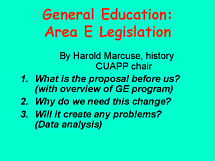
title slide
1=next five slides
2=slide no. 7
3=pedagogic, financial, procedural
(the last 4 slides were only "just in case" for answering specific
questions)
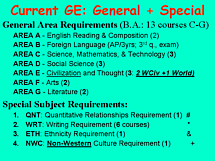
Overview of current program.
The changes in Area E and special requirement 4 are marked in bold.
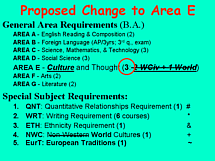
"Civilization" is to be replaced by "culture," "non-Western" by "World." Area E remains at three courses, and "European Traditions" (no. 5 at bottom) is introduced as a content requirement, as Western Civ. could (and should) have been from the start.
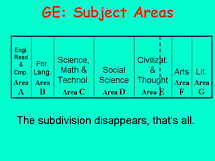
schematic rendition of the core area (disciplinary) requirements.
3-course areas are wider than 2-course requirements
(C,D,E vs. F,G).

well, the word "civilization" changes
to "culture," too.
[I needed a separate slide because I don't know
how to make something disappear from a ppt slide.]

Area E's definition is updated by changing one word, EurT is introduced, and "non-Western" is updated by changing its name so that it isn't defined by the absence of something.
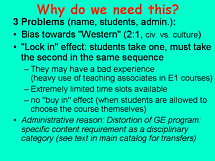
What problems does this change solve?
1. West="civilized", World has "culture" and "West" gets double coverage;
2. Allowing students to choose has multiple advantages;
3. makes GE program more internally consistent and easier to analyze.

Actually, there are 3 arguments against, but this is the only pedagogic argument. The two others--financial and procedural--are addressed in the next slides. We find the pedagogic argument decisively contravened, also by ESCI question B data not included here.
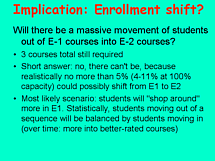
Departments are worried that this change might precipitate a sharp drop in enrollments that would reduce their TAship allocations. Data analysis shows that this is impossible, since there is very little available room in E2 courses.

Schematic rendition of area E enrollments. ALL E2 courses filling up to 100% capacity would allow only 913 students to move out of area E1. That shift is not "TA-relevant." The only real possiblity: students will "shop around" within E1 more, over time gravitating towards the better courses. This provides an incentive for departments to keep quality high in their offerings.

The third reason we've heard against this proposal is that proper consultation
procedures were not followed. However, we think that 3 years is more
than ample time to consider this.
Also, there is urgency to this reform, so that advising of incoming transfers can incorporate this, and so that publications can be prepared for next year. A Fall 2004 vote would make this VERY tight.

I wasn't planning on showing this & the following slides unless
questions about enrollment implications were raised. It shows the relative
contribution of the five departments that offer courses in E1.
Note that for each 1-course requirement, about 4000 seats should be available (size of freshman class). This ignores IGETC transfers and students who don't need to fulfill the requirement (ca. 1000).
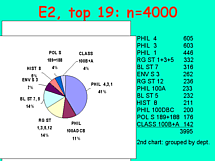
This pie chart shows the courses now in Area E2 with the largest average annual enrollments.
(The pie chart you can't see shows the distribution by individual course; this one aggregates by department.)
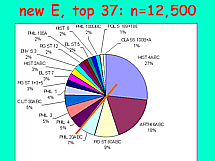 This
pie chart shows the overall dis- tribution of choices students will have
once E1 and E2 are integrated. The "top 37" are the 19 in the
previous slide, and 18 courses now in E1 (French & Italian's "Tales
of Love" was added in 03-04, and isn't in the E1 pie chart, above).
This
pie chart shows the overall dis- tribution of choices students will have
once E1 and E2 are integrated. The "top 37" are the 19 in the
previous slide, and 18 courses now in E1 (French & Italian's "Tales
of Love" was added in 03-04, and isn't in the E1 pie chart, above).

Some people expressed concern that "any" courses could be approved for "European Traditions." They want only broad survey-type courses to be approved for this special subject requirement. This amendment could be introduced in the fall when the other core area definitions are to be updated.